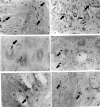Application of light microscopical and ultrastructural immunohistochemistry in the study of goblet cell carcinoid in the appendix
- PMID: 18252007
- PMCID: PMC2275273
- DOI: 10.1186/1477-7819-6-15
Application of light microscopical and ultrastructural immunohistochemistry in the study of goblet cell carcinoid in the appendix
Abstract
Background: Goblet cell carcinoids appear less frequently in the appendix than do other carcinoids. In the presented work a case with a goblet cell carcinoid of the appendix is described.
Methods: Routine histological and histochemical methods were employed, with a combination of histochemistry and immunohistochemistry on one section and light and electron microscopical immunohistochemisty on paraffin-embedded material, were applied to identify the type of the carcinoid and to reveal the fine structure of cell types in the tumour nests of the appendix.
Results: During the biopsy of a patient who had undergone appendectomy, an infiltration with clusters of goblet cells in the submucosa of the appendix was found. After a second operation of right-sided hemicolectomy, similar clusters of goblet cells were detected in the muscle layers of the caecum. After 18 months the patient died from cirrhosis and had not developed metastases or any recurrence. Immunohistochemically the serotonin-, somatostatin-, chromogranin A- and synaptophysin-positive endocrine cells were basally attached to mucin-secreting cells. The combined staining revealed simultaneously present endocrine cells (chromogranin-A-positive) and mucin-secreting cells (PAS- or alcian blue-positive). The ultrastructural immunohistochemistry showed that chromogranin A-positive cells had discoid and pleomorphic granules and were located in tumour nests or as single cells in the appendiceal wall.
Conclusion: The combined histochemical and immunohistochemical procedure and the ultrastructural immunohistochemistry on archival material could contribute in clarifying the diagnosis of goblet cell carcinoid.
Figures





Similar articles
-
Goblet cell carcinoids of the appendix: immunophenotype and ultrastructural study.Arch Pathol Lab Med. 2001 Mar;125(3):386-90. doi: 10.5858/2001-125-0386-GCCOTA. Arch Pathol Lab Med. 2001. PMID: 11231488
-
Goblet cell carcinoid tumors (adenocarcinoid) of the appendix.Dis Colon Rectum. 2007 Mar;50(3):315-22. doi: 10.1007/s10350-006-0762-4. Dis Colon Rectum. 2007. PMID: 17195086
-
Goblet cell carcinoid of the appendix endoscopically diagnosed and examined with p53 immunostaining.J Gastroenterol. 1998 Aug;33(4):582-7. doi: 10.1007/s005350050138. J Gastroenterol. 1998. PMID: 9719248
-
Goblet cell carcinoids of the appendix.ScientificWorldJournal. 2013;2013:543696. doi: 10.1155/2013/543696. Epub 2013 Jan 14. ScientificWorldJournal. 2013. PMID: 23365545 Free PMC article. Review.
-
[Goblet cell carcinoid of the appendix].Vnitr Lek. 2009 Nov;55(11):1056-9. Vnitr Lek. 2009. PMID: 20017437 Review. Czech.
Cited by
-
[Metastazation into the seminal vesicles due to primary goblet cell carcinoid of the vermiform appendix. An unusual diagnostic procedure of a seminal vesicle tumor].Urologe A. 2009 Nov;48(11):1352-5. doi: 10.1007/s00120-009-2084-3. Urologe A. 2009. PMID: 19705095 German.
-
Goblet cell carcinoid tumors of the appendix: An overview.World J Gastrointest Oncol. 2010 Jun 15;2(6):251-8. doi: 10.4251/wjgo.v2.i6.251. World J Gastrointest Oncol. 2010. PMID: 21160637 Free PMC article.
-
Goblet cell carcinoids of the appendix: Tumor biology, mutations and management strategies.World J Gastrointest Surg. 2016 Oct 27;8(10):660-669. doi: 10.4240/wjgs.v8.i10.660. World J Gastrointest Surg. 2016. PMID: 27830037 Free PMC article. Review.
-
Immunohistochemical features of the gastrointestinal tract tumors.J Gastrointest Oncol. 2012 Sep;3(3):262-84. doi: 10.3978/j.issn.2078-6891.2012.019. J Gastrointest Oncol. 2012. PMID: 22943017 Free PMC article.
-
Enteric neuromodulators and mucus discharge in a fish infected with the intestinal helminth Pomphorhynchus laevis.Parasit Vectors. 2015 Jul 8;8:359. doi: 10.1186/s13071-015-0970-7. Parasit Vectors. 2015. PMID: 26152567 Free PMC article.
References
-
- Burke AP, Sobin LH, Federspiel BH, Shekitka KM, Helwig EB. Goblet cell carcinoids and related tumors of the vermiform appendix. Am J Clin Pathol. 1990;94:27–35. - PubMed
-
- Capella C, La Rosa S, Uccella S, Billo P, Cornaggia M. Mixed endocrine-exocrine tumors of the gastrointestinal tract. Semin Diagn Pathol. 2000;17:91–103. - PubMed
-
- Oberg K, Astrup L, Eriksson B, Falkmer SE, Falkmer UG, Gustafsen J, Haglund C, Knigge U, Vatn MH, Valimaki M. Guidelines for the management of gastroenteropancreatic neuroendocrine tumours (including bronchopulmonary and thymic neoplasms). Part I-general overview. Acta Oncol. 2004;43:617–625. doi: 10.1080/02841860410018575. - DOI - PubMed
-
- Burke AP, Sobin LH, Federspiel BH, Shekitka KM. Appendiceal carcinoids: correlation of histology and immunohistochemistry. Mod Pathol. 1989;2:630–637. - PubMed
Publication types
MeSH terms
Substances
LinkOut - more resources
Full Text Sources
Medical
Research Materials

